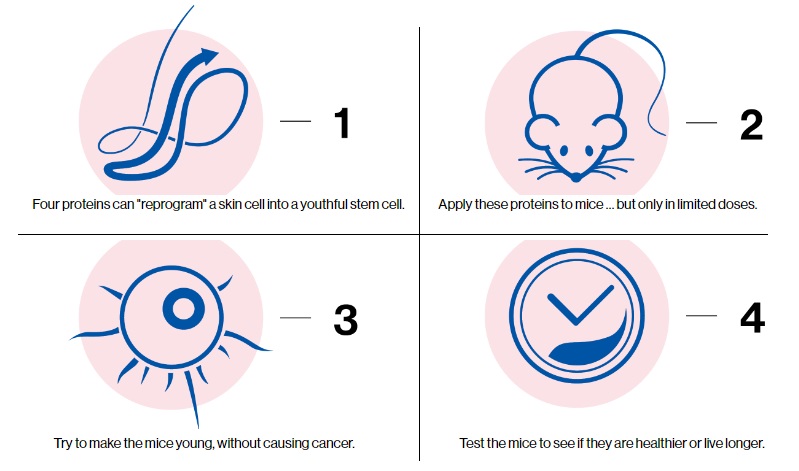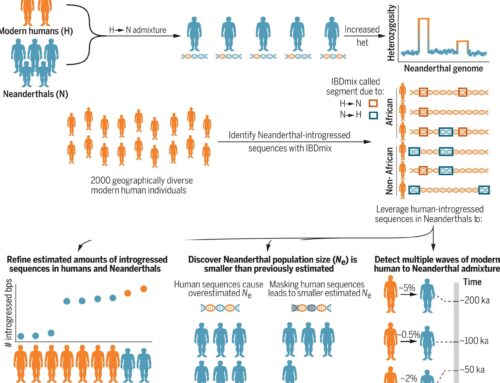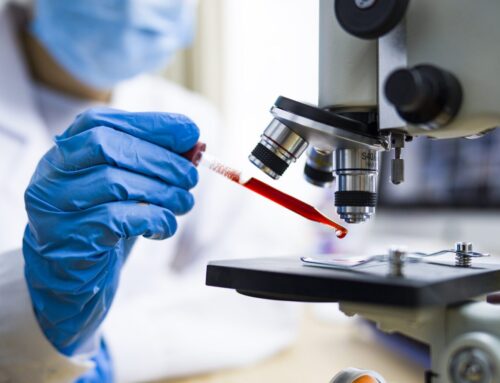
Research labs are pursuing technology to “reprogram” aging bodies back to youth.
Article courtesy of MIT Technology Review
A little over 15 years ago, scientists at Kyoto University in Japan made a remarkable discovery. When they added just four proteins to a skin cell and waited about two weeks, some of the cells underwent an unexpected and astounding transformation: they became young again. They turned into stem cells almost identical to the kind found in a days-old embryo, just beginning life’s journey.
At least in a petri dish, researchers using the procedure can take withered skin cells from a 101-year-old and rewind them so they act as if they’d never aged at all.
Now, after more than a decade of studying and tweaking so-called cellular reprogramming, a number of biotech companies and research labs say they have tantalizing hints the process could be the gateway to an unprecedented new technology for age reversal. By applying limited, controlled doses of the reprogramming proteins to lab animals, the scientists say, they are seeing evidence that the procedure makes the animals—or at least some of their organs—more youthful.
One of the key promoters of this idea, Richard Klausner, took the stage in June at a glitzy, $4,000-per-ticket retreat in San Diego, where he flashed data from unpublished experiments in which sick mice bounced back to health after undergoing the experimental treatment.
Klausner was pitching nothing less than “medical rejuvenation”—a means of taking old animals and making them “young.” He is the organizer and chief scientist of Altos Labs, a new research company seeded with more than $3 billion from ultra-wealthy figures in Silicon Valley and oil money from the Persian Gulf. Klausner and his financiers had swept up dozens of top scientists—offering salaries of $1 million and more—and set them to work on a technology the company now calls “rejuvenation programming.”
The idea that humans could be frozen and later brought back has survived for decades. The hope is still alive and even growing today—never mind that it’s still not possible.
The objective of Altos is to tame this phenomenon, understand it, and eventually apply it as a treatment to reverse a wide range of diseases. This may be possible, Klausner says, because youthful cells have more resilience and can bounce back from biological stress in ways old ones don’t. And Klausner has data to suggest it might already be working. During his talk, he showed slides marked “Confidential” claiming that fat mice had recovered from diabetes after treatment, and that others were able to survive normally lethal doses of painkillers—all thanks to a healthy dose of the medical rejuvenation.
“We think we can turn back the clock,” he told the audience.
Klausner is the former head of the National Cancer Institute and onetime leader for global health at the Gates Foundation. He is a heavy hitter who has also been behind some of today’s most high-profile biotech ventures, like the cancer blood-test company Grail. Yet even for him, rejuvenation is wildly ambitious. That is because if you can make cells act younger, healthier, and more resilient, you might have a general-purpose means of forestalling many diseases all at once. “This is the opposite of precision medicine,” Klausner said.
Fountain of rejuvenation
To be sure, the word “rejuvenation” sounds suspicious, like a conquistador’s quest or a promise made on a bottle of high-priced face cream. Yet rejuvenation is all around us, if you look. Millions of babies are born every year from the aging sperm and egg cells of their parents. Cloning of animals is another example. When Barbra Streisand had her 14-year-old dog cloned, cells from its mouth and stomach were returned to her as two frolicking puppies. These are all examples of cells being reprogrammed from age to youth—exactly the phenomenon companies like Altos want to capture, bottle, and one day sell.
For now, no one has a firm idea what these future treatments could look like. Some say they will be genetic therapies added to people’s DNA; others expect it’s possible to discover chemical pills that do the job. One proponent of the technology, David Sinclair, who runs an aging-research lab at Harvard University, says it could allow people to live much longer than they do today. “I predict one day it will be normal to go to a doctor and get a prescription for a medicine that will take you back a decade,” Sinclair said at the same California event. “There is no reason we couldn’t live 200 years.”
It’s this type of claim that raises so much skepticism. Critics see ballooning hype, runaway egos, and science that’s on uncertain ground. But the doubters this year were drowned out by the sound of stampeding investors. In addition to Altos, whose $3 billion ranked as possibly the single largest startup fundraising drive in biotech history, the cryptocurrency billionaire Brian Armstrong, the cofounder of Coinbase, helped bring $105 million into his own reprogramming company, NewLimit, whose mission he says is “radical extension of human health span.” Retro Biosciences, which says it wants to “increase healthy human lifespan by 10 years,” raised $180 million.
These huge expenditures are being made despite the fact that scientists still disagree on the causes of aging. Indeed, there’s no real consensus on when in life aging even begins. Some say it starts at conception, while others think it’s at birth or after puberty.
“There is no reason we couldn’t live 200 years.”
David Sinclair, Harvard University
But all the unknowns are part of what makes the reprogramming phenomenon so attractive. Klausner admits that the details of why reprogramming works remain a “complete mystery,” but that too helps explain the sudden rush to invest in the idea. If there is a fountain of youth in the genome, the first to locate it could reinvent medicine and revolutionize how we treat the myriad of diseases that plague our old age.



